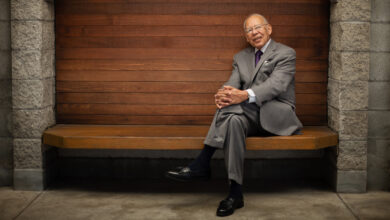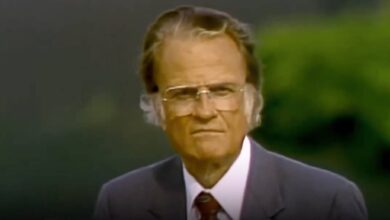David Brooks: We Change People for the Better by Knowing Them …

Twenty years ago, I got stuck in the back of a van with a rather dull missionary.
All of us missionaries were on some trip, and I found myself preparing for hours of driving with this man as my companion. I didn’t know him, but I sensed that if we got to talking, then some political and cultural differences were going to become painfully obvious.
In short, I judged this man, fiercely, before he so much as opened his mouth. I had sized him up, categorized him, set barriers between us, and thereby diminished him and myself in the process. All this, I think, makes me a more or less normal human being. We are constantly doing this to each other.
But before the van ride began, I recall feeling a rare and particularly painful prompting of the Holy Spirit. In a moment I have never forgotten, a phrase flashed through my mind: “There is no such thing as a boring person.”
I felt convicted and inspired all at once. As a missionary, I constantly found myself speaking with students about the dignity of human life, and how that couldn’t be explained without God. Yet I had denied my fellow missionary’s image-bearing dignity before I even knew his name.
I ended up spending hours of that van ride getting to know a human being I still think of very fondly. Years later I still smile at his concern for his children, the compliments he gave his wife, and his tired but very real smile. I doubt he remembers this ride, but my life was changed by a small prompting from God to pay attention to someone I had instinctively diminished.
‘Illuminators’ and ‘Detractors’
All of this brings me to the latest book from New York Times columnist David Brooks, How to Know a Person: The Art of Seeing Others Deeply and Being Deeply Seen. In an uncanny echo of the language that marked my own epiphany, Brooks writes, “There is no such thing as an ordinary person.” Perhaps that sounds trite at first, like saying the universe is big. But there is no end of awe once you experience that truth.
Brooks’s phrasing also evokes a passage from C. S. Lewis’s sermon “The Weight of Glory.” His opening chapters brought to mind Lewis’s reminder, in that sermon, that angels or demons are always lurking beneath ordinary human fa çades. “It is a serious thing to live in a society of possible gods and goddesses,” Lewis wrote, “to remember that the dullest and most uninteresting person you can talk to may one day be a creature which, if you saw it now, you would be strongly tempted to worship, or else a horror and a corruption such as you now meet, if at all, only in a nightmare.”
Brooks’s major claim in How to Know a Person is that extraordinary things happen when we pay attention to other people. On both a personal and a national scale.
For Brooks, our declining ability to relate to one another is at the root of our public crises, from political divisiveness to economic insecurity. Both personally and socially, Brooks argues, we collapse when we do not feel seen. But his primary aim is not saving democracy or easing workplace turnover. This book is much more personal. Brooks writes less like a prestigious newspaper columnist talking to the country than a father talking to his children. And the approach works.
He seems to have genuinely experienced a change in his own life. As a result, he wants to tell you that your greatest joys will be found in full relationships—and how your greatest sorrows will come from the broken ones. I, for one, found myself wanting to listen.
Brooks divides the world into categories that, for him, merit proper nouns: “Illuminators,” whose attention to other people enhances them, and “Detractors,” whose indifference to other people diminishes them. Brooks is at his best when he’s telling stories of Illuminators. And stories are a big part of the book. Some are his own, but as befits a seasoned journalist, most of them revolve around other people.
Some sections of the book offer practical suggestions on how to be an Illuminator, even specific tips on what to say in conversation. One that immediately struck me was the reminder that attention is an on/off switch, not a dimmer. When you give it, give it fully.
My favorite example in the book highlights someone familiar to many readers of CT, the author and journalist (and former CT editor) Andy Crouch. Brooks credits him with “listen[ing] to other people as if he were a congregant in a charismatic church. While you’re talking, he fills the air with grunts and ahas, amens, hallelujahs, and cries of ‘Preach!’ I love talking to that guy.” As someone grateful to have shared a few such “charismatic conversations” with Andy, I couldn’t agree more. Those moments changed me, which illuminates Brooks’s point: We are changed by people who pay us true attention.
This is a claim worth pausing to seriously consider. Brooks means that really seeing someone is not just good for your empathy or understanding, but ultimately good for the other person, in that our attention to others brings out a new version of that person. We alter people simply by seeing them.
In that way, illumination is not just a life hack to better understand the world around you. It is a profound act of love. It reminds me of the way God’s love makes us lovable.
In one of the strongest claims of the book, Brooks argues that this kind of attention is a moral act. Such a belief, he cautions, is not necessarily predicated on believing in God. Even so, his language will ring familiar to Christian readers, and Brooks invites all his readers to at least believe in the concept of a soul.
Warm mutuality
It bears repeating that there is nothing explicitly Christian about this book, even if Christian readers ought to find themselves longing for a world where more people treat others as God’s image-bearers. The book, though, is not all about how we treat others. One of its core themes is that our life, more than the sum of what has happened to us, is what we make of what has happened to us.
Brooks seems to issue this as a cheerful challenge. He doesn’t really dwell on the fact that many of our cultural identity narratives run in the opposing direction. Instead, he offers a steady drumbeat of science, sociology, and good storytelling to remind us that human beings cannot be reduced to either their experiences or their suffering. And Brooks doesn’t shortchange pain and suffering. Much of the book’s middle focuses on seeing people “in their struggles.”
In a rich chapter on suffering, Brooks writes that sharing our grief and pain with others is how “we overcome fear and know each other at the deepest level.” Quoting one of my favorite authors, Frederick Buechner, he writes, “It is important to tell at least from time to time the secret of who we truly and fully are … because otherwise we run the risk of losing track of who we truly and fully are and little by little come to accept instead the highly edited version which we put forth in hope that the world will find it more acceptable than the real thing.”
I found this chapter one of the most compelling, and it resonates with my own goals in writing a recent book on friendship, Made for People, where I argue that you cannot experience God the way you were meant to until you do it alongside other people. I felt a friend in Brooks, because he came to a high point in this chapter, insisting that character formation is not the solitary grunt work of the driven individual but the warm mutuality of living life while seeing and being seen.
As with any fatherly advice, some parts of the book might seem lofty or implausible. And on the other end of the spectrum, some of his advice can seem overly commonsensical, as though he were simply repeating things readers should have learned from their actual parents.
Still, it’s noteworthy that such commonsensical truths need repeating in today’s culture. David Foster Wallace famously wrote that the most important realities are often the hardest to see and talk about. The topic of knowing others feels like that. How have we come to a point where most people seem ill-prepared to treat others as deserving of our full attention? I don’t know. But we have. Why isn’t this a five-alarm fire? Brooks is trying to make it one.
Loving and lingering
Though Brooks never puts it quite this way, I left the book with the sense that seeing others is, above all else, a way of loving others. In other words, it’s an essential precondition of fulfilling the Great Commandment. If Jesus tells us to love God and love neighbor, it is assumed that we know God and see our neighbors.
Christians often intuit the first part, that loving God involves studying him. But Brooks’s book reminded me that the same needs to be true for other people. How could I love my neighbor without lingering, without making eye contact, without asking good questions—in short, without wondering, Why do they think that way?Why did they vote for that person?What are they afraid of?Why are they afraid of it?
Sure, the universe is big. Sure, no one is boring. But what if we really gave such awesome truths the deep attention they deserve? That’s Brooks’s challenge.
And for me, at least, it worked. A short while ago, during a conversation with my wife, Lauren, she said something that I wanted to take offense at. Initially, my mind began mounting a defense to explain my actions. But in real time the book came to mind, and suddenly I genuinely wondered, What if, instead of defending my view, I explored hers? So I asked a question. It led to a great conversation. I’ve loved her for 16 years, but I saw her in a new way.
All by themselves, moments like that make How to Know a Person an abundantly worthy investment.
Justin Whitmel Earley is a writer, speaker, and lawyer living in Richmond, Virginia. He is the author of Made for People: Why We Drift into Loneliness and How to Fight for a Life of Friendship.




